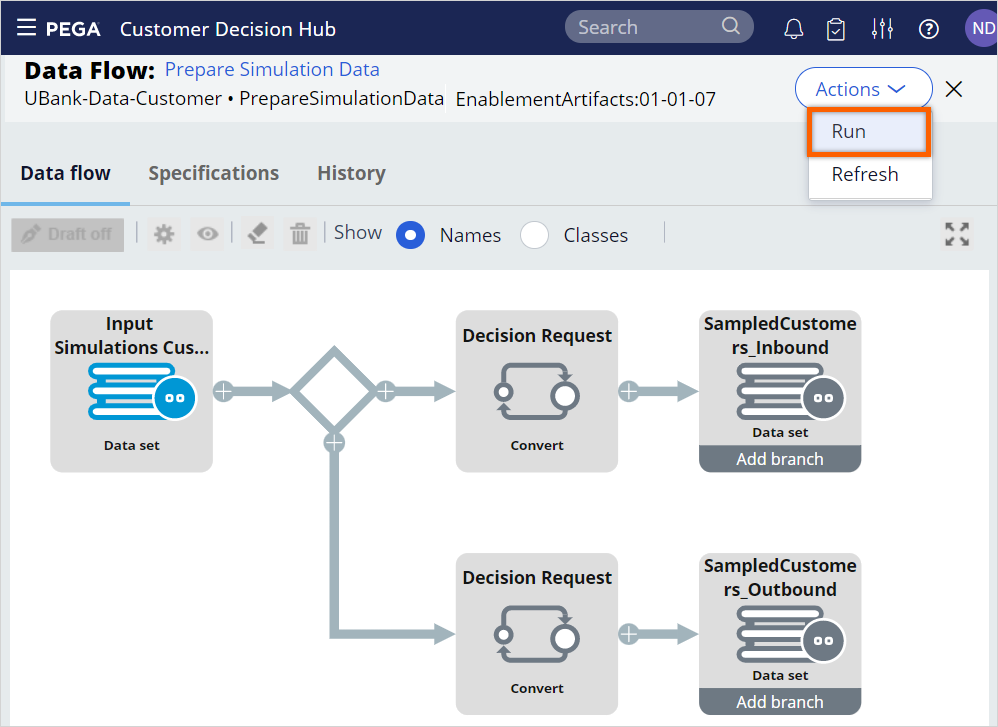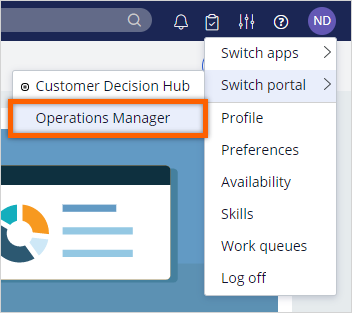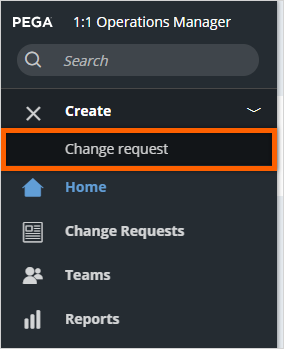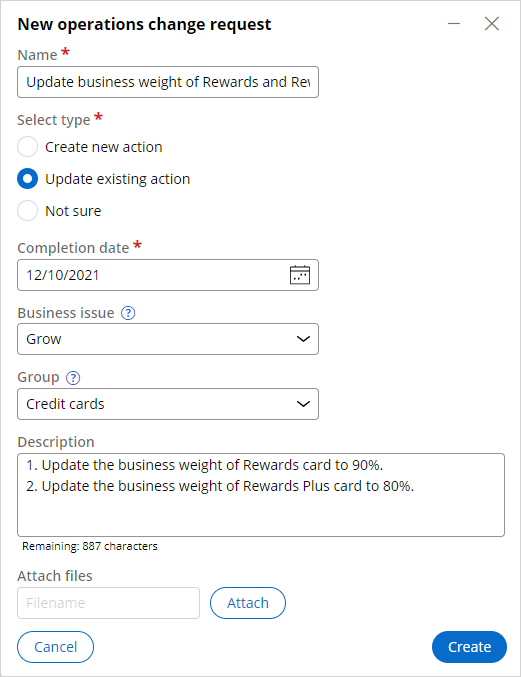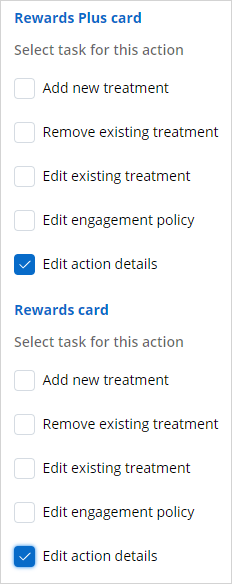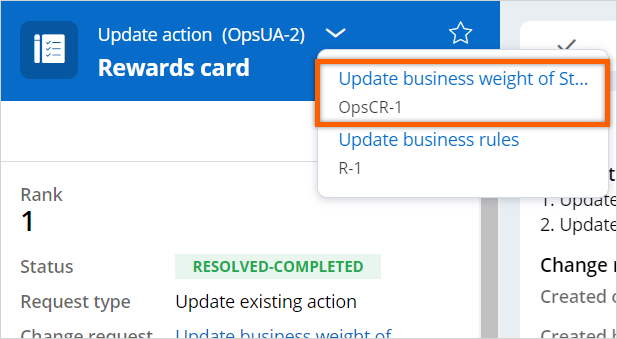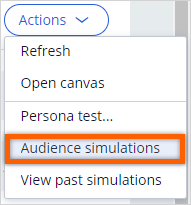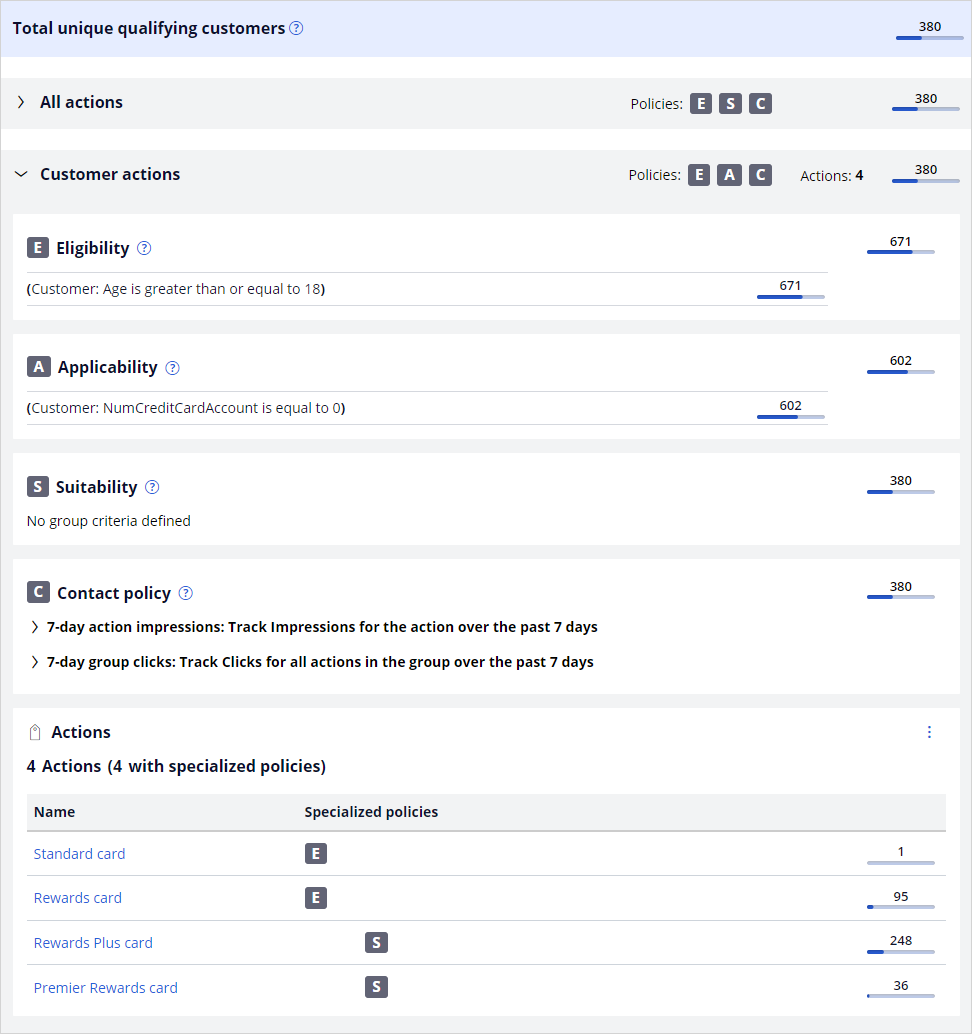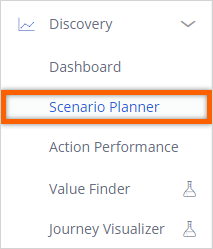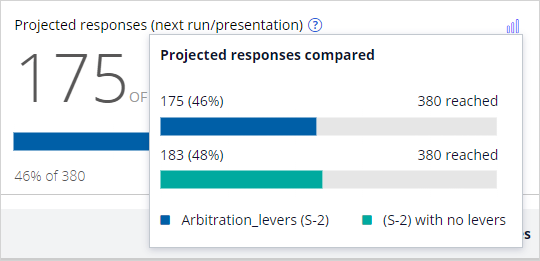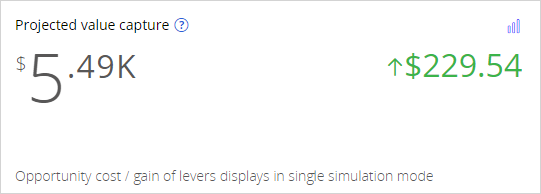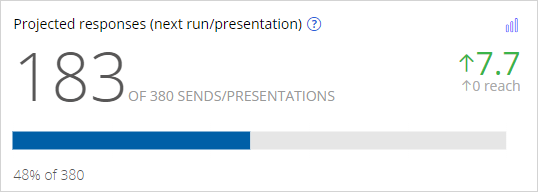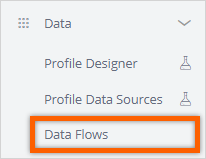
Analyzing simulation results using Scenario Planner
6 Tasks
30 mins
Scenario
U+ Bank is currently cross-selling on the web by showing various credit cards to its customers in Pega Customer Decision Hub™.
The bank wants to boost two credit card actions by applying a business weight. The bank wants to understand the opportunity cost or gain in using levers to adjust AI prioritization.
Use the following credentials to log in to the exercise system:
| Role | User name | Password |
|---|---|---|
| Next-Best-Action Designer | NBADesigner | rules |
| Team Lead | TeamLead | rules |
Your assignment consists of the following tasks:
Task 1: Prepare data set for the simulation run
Run the PrepareSimulationData data flow to prepare the data set for the simulation run.
Note: The Sampled Customers_Inbound is not available in a persisted store. To initialize the customer data, first, run the PrepareSimulationData data flow.
If you already run the PrepareSimulationData in this exercise system as part of a previous challenge, you do not need perform this task.
If you already run the PrepareSimulationData in this exercise system as part of a previous challenge, you do not need perform this task.
Task 2: Create a change request to add business weight to actions
Submit a change request to update the existing actions; to add a business weight to Rewards Plus card and Rewards card actions to manually nudge the offers.
| Action | Business Weight |
|---|---|
|
Rewards card |
90% |
|
Rewards Plus card |
80% |
Task 3: Prioritize the created change request
As a Team Lead, assign a rank of 1 to the change request that is submitted by the NBA Designer.
Task 4: Complete action build tasks
As an NBA Specialist, complete the two build tasks that the system generates to update the Rewards Plus and Rewards card actions that are defined in the change request.
Task 5: Create and execute an arbitration audience simulation
Create and execute an audience simulation. Use the SampledCustomers_Inbound data set as the audience and engagement policy and arbitration as the simulation scope.
Task 6: Analyze the simulation results in Scenario Planner
Analyze the audience simulation with the arbitration in Scenario Planner to understand the effects of adding business weight to the actions. Answer the following questions:
- What is the effect of applying the business levers? Is there any indication of an opportunity cost or opportunity gain?
- How does the application of business levers affect the percentage of accepts?
- Which actions are traded off if the business levers are applied and what is the volume?
- How many times is the Rewards card sent or presented to customers before and after applying business levers?
- How many customers are likely to accept the Standard card when the business levers are not applied?
- Which action is generating the most significant opportunity cost when the levers are applied?
- Which action is generating the most significant opportunity gain when the levers are applied?
- Which scenario is more profitable for the business?
Challenge Walkthrough
Detailed Tasks
1 Prepare data set for the simulation run
- On the exercise system landing page, click Pega CRM suite to log in to Customer Decision Hub.
- Log in as Next-Best-Action Designer with User name NBADesigner and Password rules.
- In the navigation pane of Customer Decision Hub, click Data > Data Flows to view the list of data flows.
- Search for and then open the PrepareSimulationData data flow to prepare the data set used for simulations. This data is based on a Monte Carlo dataset, which is generated by the system.
- Click Actions > Run to initialize the customer data.
- Click Submit.
- Click Start to process the data, and then wait for the processing to complete.
Note: Notice that the prospect data is populated once the test run is complete.
- Close the data flow window.
2 Create a change request to add business weight to actions
- In the upper-right corner of Customer Decision Hub, click the NBA Designer icon, and then select Switch portal > Operations Manager.
- Click OK to confirm the switch to the Operations Manager portal in Pega 1:1 Operations Mananger™.
- In the navigation pane of 1:1 Operations Manager, click Create > Change Request to create an offer in the New operations change request dialog box.
Note: In a Business change operational environment, change requests are likely to be created by business users or team leads. For the purpose of this challenge, we are using the NBA Designer simplicity of access.
- In the New operations change request dialog box, configure the following details:
- In the Name field, enter Update business weight of Rewards and Rewards Plus cards.
- In the Select type section, select Update existing action.
- In the Completion date field, select a date in the future.
- In the Business issue list, select Grow.
- In the Group list, select Credit cards.
- In the Description text box, enter the following message: 1. Update the business weight of Rewards card to 90%.
2. Update the business weight of Rewards Plus card to 80%. - Click Create to specify the details of the actions.
- In the Specify details for update existing action section, select the following checkboxes:
- Rewards Plus card
- Rewards card
- Click Continue to select the tasks for each action.
- In the Select action list for update section, select the tasks for each action:
- Select the Edit action details checkbox for both card actions.
- Select the Edit action details checkbox for both card actions.
- Click Continue to edit the attributes of the actions.
- In the Edit availability & attributes section, select the tasks for each action:
- In the Business weight field, in the Rewards Plus card column, change the business weight to 80.
- In the Business weight field, in the Rewards card column, change the business weight to 90.
- Click Finish to confirm the details.
- In the lower-left corner, click the user profile image, and then select Log off to sign out as the NBA Designer.
3 Prioritize the created change request
- Log in to 1:1 Operations Manager as a Team Lead with User name TeamLead and Password rules.
- In the navigation pane of 1:1 Operations Manager, click Change Requests to view the list of change requests.
- On the list of change requests, click the Update business weight of Rewards and Rewards Plus cards change request.
- In the To do list, to the right of Rank change request, click Go to open the Rank change request section.
- In the Rank change request section, in the Rank field, enter 1.
- Click Submit to submit the rank.
- In the lower-left corner, click the user profile image, and then select Log off to sign out as the Team Lead.
4 Complete the action build tasks
- Log in as the Next-Best-Action Designer with User name NBADesigner and Password rules.
- In the upper-right corner of 1:1 Operations Manager click the NBA Designer icon, and then select Switch portal > Operations Manager.
- Click OK to confirm switching to Operations Manager.
- In the navigation pane of 1:1 Operations Manager, click Change Requests to view the list of change requests.
- In the list of change requests, click Update business weight of Rewards and Rewards Plus cards change request.
- To the right of the Define action details task of the Rewards Card, click the More icon, and then select Assign to myself.
- To the right of the task, click Go.
- Scroll down to see the details in the description.
- Scroll up, and the, in the Define action details section, ensure that section reflects the details given in the following action description.
- Click Submit to review the tasks completed for the Rewards card.
- To the right of the Review all completed tasks in build stage task, click the More icon, and then select Assign to myself.
- To the right of the task, click Go.
- Review all the completed tasks in the build stage, and then click Submit.
- In the header of the case type, click the Breadcrumbs button, and thenclick Update business weight of Standard and Rewards card to return to the change request.
- Repeat steps 6-11 complete the changes for the Rewards card.
Note: The Build stage is now complete. As a result, the change request enters the Test stage. NBA Designer can proceed now with simulations to test the changes.
5 Create and execute an arbitration audience simulation
- In the lower-left corner of 1:1 Operations Manager click the user icon, and then select Switch portal > Customer Decision Hub.
- Click OK to confirm the switch to Customer Decision Hub.
- In Next-Best-Action Designer, click the Engagement policy tab.
- Click Grow > CreditCards.
- Click Actions > Audience Simulations.
- Click Create simulation to create a new audience simulation.
- In the Create simulation dialog box, configure the following details:
- In the Audience list, select SampledCustomers_Inbound.
- In the Name field, enter Arbitration_levers.
- In the Next-Best-Action scope section, select Engagement policies and arbitration.
Note: The Include a second-pass simulation without business levers (for Scenario Planner) checkbox enables you to compare the simulation results to analyze the effectiveness of assigning an increased business weight to specific actions.
- Click Run to execute the simulation.
- Wait for the simulation to show a status of Completed, and then inspect how the customers are filtered at the Next-Best-Action Designer level for every engagement policy condition.
6 Analyze the simulation results in Scenario Planner
- Question: What is the effect of applying the business levers? Is there any indication of an opportunity cost or opportunity gain?
- In the navigation pane of Customer Decision Hub, click Discovery > Scenario Planner.
- In the Scenario Planner window, enter or select the following information:
- In the Scope list, select Grow/Credit cards.
- In the Simulation list, select Arbitration_levers (S-#####).
- Click Apply.
- Inspect the results.
Note: The Monte Carlo data set generates a mock data set. As a result, different simulation runs have different results.
In this example, the Scenario Planner projects the value capture for the simulation with levers is $5.26K. The projected value capture of the simulation without levers is $5.49K. In this example, there is an opportunity cost involved as there is a difference of $229.54.
- In the navigation pane of Customer Decision Hub, click Discovery > Scenario Planner.
- Question: How does the application of business levers affect the percentage of accepts?
- In the Scenario Planner window, in the Comparison simulation list, select (S-#####) With no levers.
- Click Apply.
- In the Projected responses (next run/presentation) tile, click the Graph icon to view the difference in the percentage of accepts.
Note: In this example, the projected response for the simulation with levers is 175. the projected response for the simulation without leversis 183 . The projected responses increase when the business does not apply business levers.
- In the Scenario Planner window, in the Comparison simulation list, select (S-#####) With no levers.
- Question: Which actions are traded off if the business levers are applied and what is the volume?
- In the Projected reach column, review the projected reach per action.
Note: In this example, you can see that the 25 additional Rewards card and 47 additional Rewards Plus card offers are presented in green. The 52 fewer Premier Rewards cards and 20 fewer Standard cards are red.
- In the Projected reach column, review the projected reach per action.
- Question: How many times is the Rewards card sent or presented to customers before and after applying business levers?
Note: The Rewards card is sent or presented 95 times when the business levers are applied.
- Click the (S-#####) With no levers tab to view the results of the simulation without business levers.
- In the Projected reach column, review the projected reach per action.
- Click the (S-#####) With no levers tab to view the results of the simulation without business levers.
Note: The Rewards card is sent or presented 70 times when the business levers are not applied, 25 fewer than the scenario with business levers.
- Question:How many customers are likely to accept the Standard card when the business levers are not applied?
Note: The projected response is the number of expected accepts per card. 4 customers are likely to accept the Standard card when the business levers are not applied. That is, 4 more acceptances than the scenario with business levers.Note: When the adaptive model of an action does not have enough data projection to predict, the system indicates that there is insufficient evidence.
- Question: Which action generates the biggest opportunity cost when the levers are applied?
- Click the Premier Rewards card.
- Inspect the Projected value capture section to determine the cost of levers for this action.
Note: The Premier Rewards card generates the biggest opportunity cost when the levers are applied. The cost is equal to $1.08K.
- Click Credit cards to return to the previous screen.
- Question: Which action generates the biggest opportunity gain when the levers are applied?
- Click the Rewards Plus card.
- Inspect the Projected value capture section to determine the cost of levers for this action.
Note: The Rewards Plus card generates the biggest opportunity gain when the levers are applied. The gain is $3.44K.
- Click Credit cards to return to the previous screen.
- Question: Which scenario is more profitable for the business?
- Inspect the Projected value capture tile, and then note the opportunity gain indicated in green.
- Inspect the Projected responses tile, and then note the increase in projected responses indicated in green.
Note: In this example, the scenario with levers is more profitable as the projected value capture is higher by $229.54.
- Inspect the Projected value capture tile, and then note the opportunity gain indicated in green.
This Challenge is to practice what you learned in the following Module:
Available in the following mission:
If you are having problems with your training, please review the Pega Academy Support FAQs.
Want to help us improve this content?

